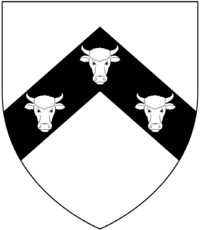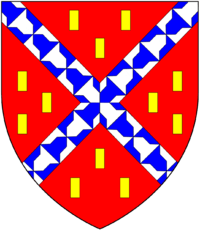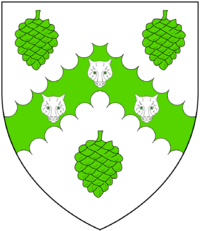Membland
Membland is an historic estate in the parish of Holbeton, Devon, situated about 8 miles south-east of the centre of Plymouth. The estate was purchased in about 1877 by Edward Baring, 1st Baron Revelstoke (1828–1897), senior partner of Barings Bank, who rebuilt the mansion house known as Membland Hall. He suffered financial troubles in the 1890's and in 1916 the estate was sold by his heir. The house had become derelict by 1939 and was demolished after World War II. Several of the estate's service buildings survive, including the Bull and Bear gatekeeper's lodge, stables, gasworks, forge and laundry. On the site of the house a smaller dwelling was built between 1966-8.[1]
History
Anciently called Mimiland,[2] it was successively the seat of the families of de Mimiland, Hillersdon,[3] Champernowne,[4] Stert,[4] Bulteel, Perring[5] and Baring.
Hillersdon

The Hillersdon family originated at the estate of Hillersdon in North Devon[6] before the 14th century. By the 16th century they had become seated at Membland.[7] Richard Hillersdon (c.1639 – 1703), of Membland, was an MP for Plympton Erle in 1679. He had one son and two daughters, but the son died in or before 1693, after which he appears to have conveyed Membland to his son-in-law Arthur Champernowne. His other daughter married Courtenay Croker (died 1740), of Lyneham, MP for Plympton as a Whig from 1695 to 1702.[8]
On 30 August 1693 Richard Hillersdon of Membland signed a deed of release to Arthur Champernowne of Modbury, relating to the "Mannor of Lambside, messuage and barton of Membland, Pool Mills, Holbeton".[9]
Champernowne

Letters survive from Arthur Champernowne (1671 – before 1717) of Membland to Courtenay Croker of Lyneham, Yealmpton.[10] Champernowne died childless at some time before 1717,[11] the last of the Champernownes of Modbury.
Stert
After 1723 the mansion house was occupied by Arthur Stert (died 1755), MP for Plymouth 1727–54,[12] who rebuilt it with detached wings.[4] He married but was predeceased by his only son, leaving two daughters.[12] His family had lived in the area around Plymouth since the early sixteenth century. In 1723 he purchased Membland from the Champernowne family.[12] He received a grant of arms in 1745 as follows: Argent, a saltire gules between four crosses formee sable, with crest: A cross formee sable between a pair of wings elevated argent.[13] One of his parliamentary colleagues wrote of him:[12]
- "They say he is an able man, but he has not the gift of utterance; he did not answer the questions put to him with readiness or clearness, but yet, I think, did give answers which might satisfy those who were not resolved not to be satisfied".
Bulteel

Membland was purchased for his residence in 1757 by John Bulteel (1733–1801), a younger son of James Bulteel (1676–1757) of Tavistock and of Flete (adjacent to Membland), MP for Tavistock 1703–8 and 1711–15,[14] by his wife Mary Crocker, daughter and heiress of Courtenay Crocker (died 1740), of Lyneham, Yealmpton. John Bulteel married Diana Bellenden, a daughter of the Scottish Lord of Parliament John Bellenden, 2nd Lord Bellenden (died 1707). A mural monument to John Bulteel survives in Holbeton Church showing two oval escutcheons[15] the one at dexter showing the arms of Bulteel: Argent semée of billets gules, a bend of the last[16] with inescutcheon of pretence of Croker of Lyneham (Argent, a chevron engrailed gules between three crows proper), the one at sinister showing Bulteel quartering Croker, impaling: Gules, a stag's head and neck couped between three cross crosslets fitchy within a double tressure flory counter-flory or (Bellenden).[17] Above both shields is the crest of Bulteel: Out of a crown gules two wings argent bilettée of the first.
Having inherited his paternal estate of Flete from his young nephew Courtenay Croker Bulteel of Flete and Lyneham, Yealmpton, Bulteel had no further use for Membland,[18] and sold it to Peter Perring.
Perring

Peter Perring (1743–1796) of the City of London was the uncle of John Bulteel's daughter-in-law Elizabeth Perring (1766–1835) (daughter and sole heiress of Thomas Perring, a merchant in the City of London), who had married his son John Bulteel (died 1837) of Flete and Lyneham.
Peter Perring had made a fortune in the East Indies.[20] He was the fourth son of Philip Perring (died 1716) of Modbury in Devon, and was the brother of Thomas Perring (1732–1791) above, and of Philip Perring (died 1797), MP, father of Sir John Perring, 1st Baronet (1765–1831). Peter went to India as a servant of Sir Thomas Rumbold, 1st Baronet (Governor of Madras from 1777 to 1780) and eventually became secretary to the government at Madras and a member of the Council of Madras, in which office he amassed a fortune of £40,000.[21] In 1781 he was dismissed from the service of the East India Company possibly for profiteering.[22] On his return to England, he married Lucinda Manning, the beautiful[21] daughter of Rev. Henry Manning, Rector of Stoke-in-Teignhead, Devon, on whom he settled £10,000 and, "in consequence of her extreme good behaviour",[21] intended settling his whole fortune upon her.[21] However he died suddenly on 8 December 1796, before he could sign his will. Peter Perring died childless and his heir to Membland became his nephew Sir John Perring, 1st Baronet (1765–1831) (son of his brother Philip), senior partner of Perrings Bank and Lord Mayor of London in 1803. His bank failed in the Panic of 1825 after which he sold his estates.
A mural monument to Peter Perring survives in Holbeton Church inscribed "In memory of Peter Perring Esqr. of Membland, late one of the Council of Fort St George in the East Indies, who died the 8th day of December 1796 aged 53".[23] Above is a large stone urn and below are shown the arms of Perring.
Baring
Membland, in about 1877, and the manor of Revelstoke were purchased by Edward Baring (1828–1897), who in 1885 was elevated to the peerage as "Baron Revelstoke of Membland". He was senior partner of Barings Bank, which had originated in nearby Exeter, Devon. In 1861 he had married Louisa Emily Charlotte Bulteel (died 1892), a daughter of John Crocker Bulteel (1793–1843) of Fleet, Holbeton, the adjoining estate, MP for South Devon 1832–4 and Sheriff of Devon in 1841.
References
- ↑ Pevsner, Nikolaus & Cherry, Bridget, The Buildings of England: Devon, London, 2004, p.566
- ↑ Risdon, Tristram (d.1640), Survey of Devon, 1811 edition, London, 1811, with 1810 Additions, p.190
- ↑ Vivian, Lt.Col. J.L., (Ed.) The Visitations of the County of Devon: Comprising the Heralds' Visitations of 1531, 1564 & 1620, Exeter, 1895, pp.469–70, pedigree of Hillersdon of Membland
- 1 2 3 Britton, John, The Beauties of England and Wales; or, Delineations Topographical, Historical and Descriptive of Each County, Vol 4, London,1803, p.136
- ↑ Risdon, p.387
- ↑ Crossette
- ↑ Vivian, p.469, pedigree of Hillersdon of Membland
- ↑ Crossette, J. S., biography of Hillersdon, Richard (c.1639-1703), of Membland, Holbeton, Devon, published in History of Parliament, House of Commons 1660–1690, ed. B.D. Henning, 1983
- ↑ Plymouth and West Devon Record Office, reference:74/670/3
- ↑ Plymouth and West Devon Record Office, Reference: 2460
- ↑ Vivian, p.165
- 1 2 3 4 Matthews, Shirley, biography of Stert, Arthur (d.1755), of Membland, nr. Modbury, Devon, published in History of Parliament, House of Commons 1715–1754, ed. R. Sedgwick, 1970
- ↑ Encyclopaedia Heraldica, Or Complete Dictionary of Heraldry, Volume 2 By William Berry
- ↑ http://www.historyofparliamentonline.org/volume/1690-1715/member/bulteel-james-1676-1757
- ↑ See image
- ↑ In 1660 the Garter King of Arms confirmed to John Bulteel (died 1669) of Westminster (a Member of Parliament for Lostwithiel in Cornwall, from 1661 to 1669. and between c.1658 and 1667 he Secretary to Edward Hyde, 1st Earl of Clarendon, Lord Chancellor to King Charles II) the right to bear arms as follows: Argent semy of billets and a bend gules, with crest: Out of a crowne gules two wings argent billetté of the first.(Balliol College Archives & Manuscripts, Conroy Collection: Catalogue 1 – 17, 9C.3)
- ↑ http://www.heraldry-scotland.co.uk/peerage.html
- ↑ Prince, John, (1643–1723) The Worthies of Devon, 1810 edition, London, p.273
- ↑ Debrett's Baronetage of England, revised, corrected and continued by George William Collen, London, 1840, p.434, Perring Baronets
- ↑ Gray, Todd & Rowe, Margery (Eds.), Travels in Georgian Devon: The Illustrated Journals of The Reverend John Swete, 1789–1800, 4 vols., Tiverton, 1999, vol 4, p.13
- 1 2 3 4 Collinge, J.M., biography of "Perring, John (1765–1831), of Membland, Devon and New Broad Street, London", published History of Parliament, House of Commons 1790–1820, ed. R. Thorne, 1986
- ↑ Scarratt, Anne, The Woollen Industry of Modbury, The Modbury Group, 2005–13 , details regarding the Perring family and their cloth business in Modbury
- ↑ Image see
Sources
- Debrett's Baronetage of England, revised, corrected and continued by George William Collen, London, 1840, p. 434, Perring Baronets
External links
- Photographs of Membland House circa 1900(?)
- Photograps of remains of Membland estate buildings in 2015